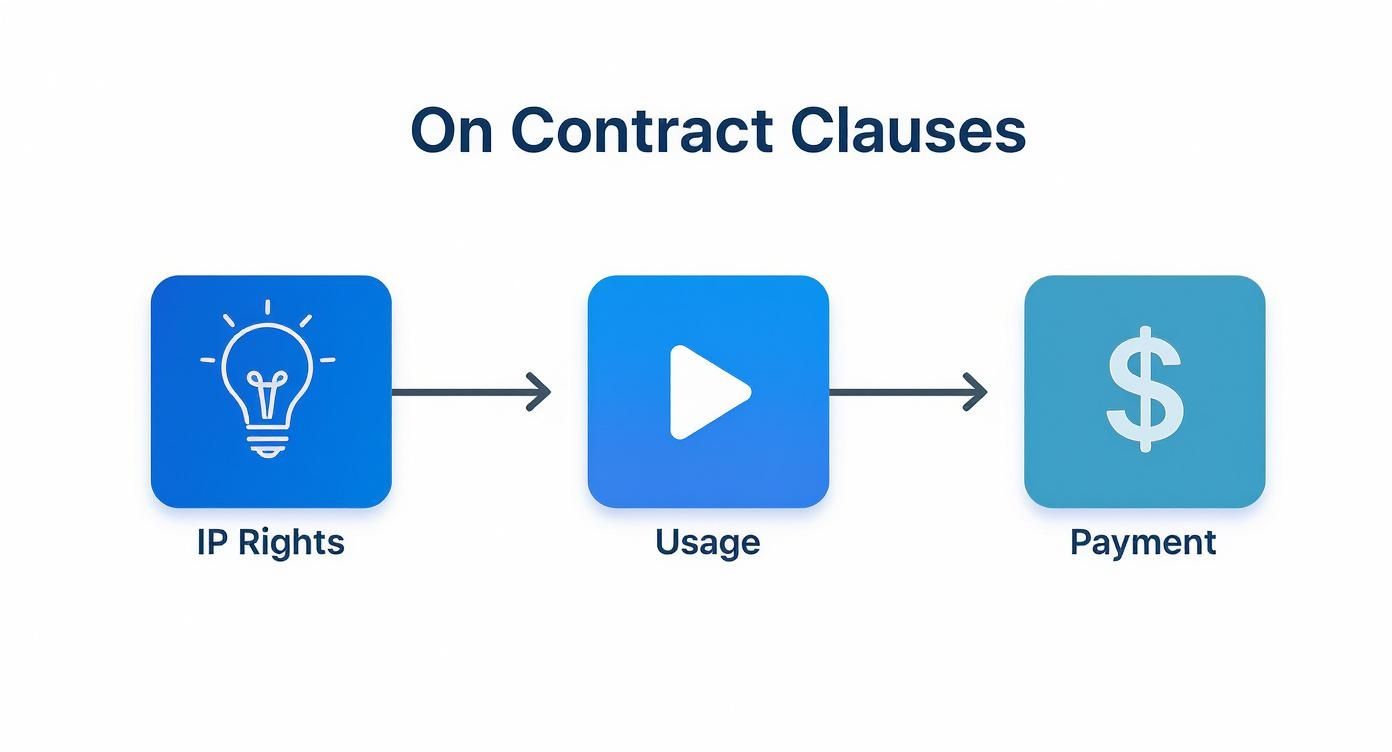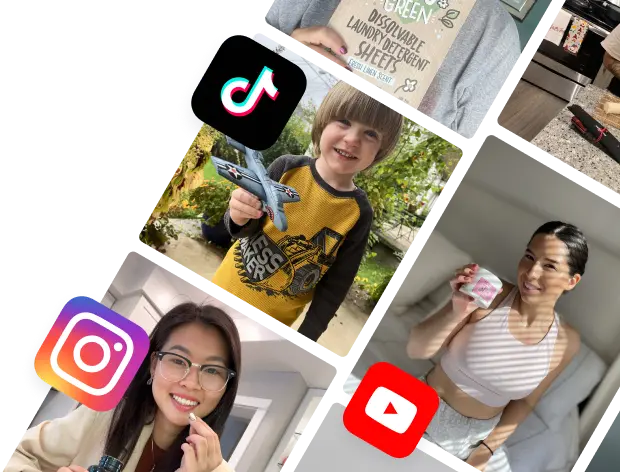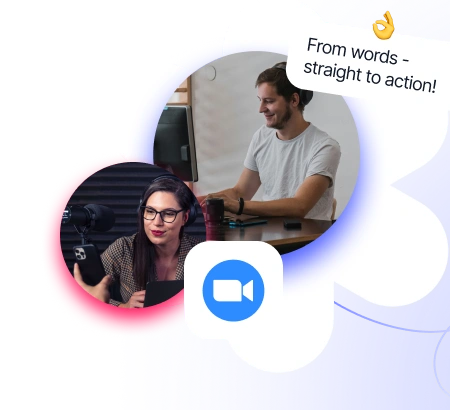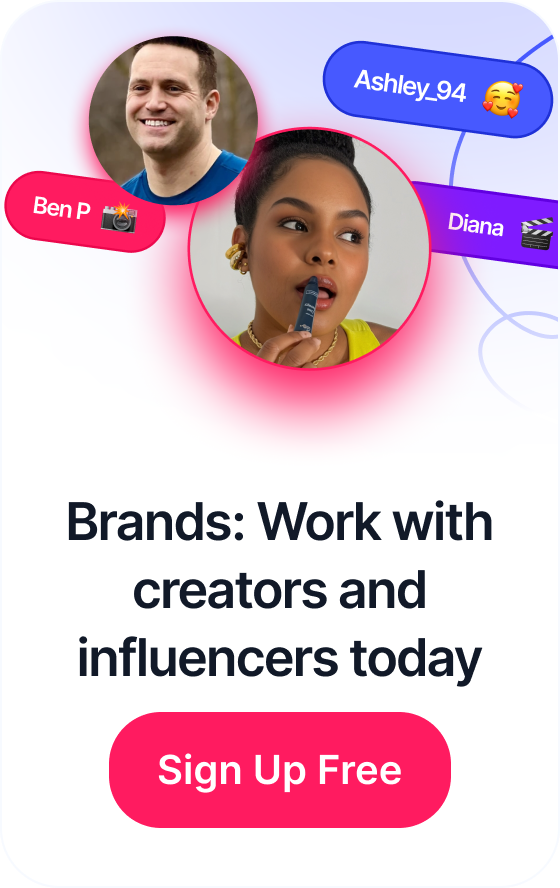 How to Find TikTok Influencers: Tips & Strategies
How to Find TikTok Influencers: Tips & Strategies
A solid content creator contract is more than just a piece of paper; it’s the blueprint for a professional and secure partnership. It’s what takes a collaboration from a risky handshake deal to a transparent agreement where everyone knows exactly what to expect.
Table of Contents
Why Smart Creators and Brands Use Contracts

In the creator economy, ditching handshake deals isn't just a good idea—it's essential for survival. For both creators and brands, working without a formal agreement is like navigating a minefield blindfolded. The risks are very real, from frustrating miscommunications to expensive legal battles that can wreck reputations and bank accounts.
Think about the all-too-common nightmare scenarios. For a creator, it could be a brand demanding endless, unpaid revisions that slowly chip away at their time and profit. Or worse, seeing their content suddenly pop up in a massive ad campaign they never agreed to, without a single extra dollar in compensation.
Brands aren't safe either. They face risks like creators blowing past deadlines, forgetting to include mandatory disclosures, or delivering content that completely misses the mark.
From Legal Shield to Professional Handshake
A well-crafted contract stops these problems before they even start. It’s not just a legal safety net; it’s a tool that builds clarity and mutual respect right from the jump, turning a casual team-up into a structured, professional partnership.
Here’s what a solid agreement really does for both sides:
- Sets Clear Expectations: It spells out the exact deliverables, timelines, and approval processes, leaving no room for guesswork.
- Defines Ownership and Usage: It clarifies who owns the content and precisely how, where, and for how long the brand is allowed to use it.
- Guarantees Fair Payment: It locks in the total compensation, payment schedule, and invoicing details, protecting creators from late or missing payments.
- Establishes Professional Boundaries: It covers key areas like exclusivity, limits on revisions, and termination clauses, making sure everyone understands the rules.
A contract isn't about mistrust; it's about creating a shared understanding. It ensures that both the creator's hard work and the brand's investment are valued and protected.
Risks of Handshake Deals vs Benefits of a Formal Contract
Informal agreements often feel faster, but they open the door to ambiguity and conflict. Here’s a quick look at why a formal contract is always the smarter choice.
| Risk Without a Contract | How a Contract Protects You |
|---|---|
| Vague expectations lead to scope creep and unpaid extra work. | Defines exact deliverables, number of posts, and revision rounds to prevent misunderstandings. |
| Disputes over payment timing and amounts. | Specifies payment milestones, rates, and due dates, ensuring timely and accurate compensation. |
| Unclear content ownership and usage rights. | Clearly outlines who owns the IP and grants specific licenses for where and how long content can be used. |
| No recourse if one party fails to deliver or disappears. | Includes termination clauses that outline a clear exit strategy and consequences for breach of contract. |
| Potential FTC non-compliance and legal trouble. | Mandates necessary disclosures (e.g., #ad, #sponsored) to comply with advertising regulations. |
Putting these terms in writing transforms a potential headache into a smooth, professional collaboration where everyone is on the same page.
The explosive growth of the creator economy has made these agreements the new industry standard. With influencer marketing projected to become a $33 billion industry by 2025, this professional shift is a natural evolution. In fact, the use of formal contracts in campaigns jumped from around 45% in 2018 to over 75% in 2023. This trend shows that the industry gets it: clarity and legal protection are non-negotiable.
Ultimately, a content creator contract is the foundation for a successful and lasting partnership. It gives both parties the confidence to collaborate, knowing their rights and responsibilities are crystal clear. For those wanting to dig deeper into the specifics, especially for performance-based deals, a comprehensive guide to affiliate contract agreements is a great place to start.
Breaking Down Your Contract Template Clause by Clause
Let's be real: a content creator contract can look like a wall of dense legal jargon designed to make your eyes glaze over. But don't be intimidated. Every single clause is in there for a reason, and understanding the "why" behind them turns a scary legal document into a clear roadmap for your project.
Think of it as the rulebook for the collaboration. It gets you and the brand on the same page, protecting everyone involved and making sure there are no nasty surprises down the road. Let’s pull back the curtain on the most important clauses you'll find in any solid agreement.
Intellectual Property Rights: Who Really Owns the Content?
This one is a big deal—maybe the biggest in the whole contract. It answers one simple but mission-critical question: Who owns the content after you’ve created it? The answer dictates who has the final say over the photos, videos, or anything else you produce.
You'll usually see this go one of two ways:
- Assignment (Transfer of Ownership): This is when you permanently sell the content to the brand. They own it outright, forever, and can use it however they want. You'll see this pop up a lot in User-Generated Content (UGC) campaigns where brands need total flexibility. If you agree to an assignment, your fee needs to be significantly higher to make up for the fact you’re giving up all future control.
- License (Permission to Use): This is way more common and usually the better route for creators. A license means you keep ownership of your work but give the brand permission to use it under very specific conditions. This keeps you in control of your work and your image long-term.
Nailing down the IP clause from the start prevents those nightmare scenarios where you see your work being used in ways you never, ever agreed to.
Usage and Licensing: Where and How Can They Use It?
If the IP clause is about who owns the content, the usage clause is all about the how, where, and for how long. This is where you have to get granular. If you don't set clear limits, a brand might think they can run your content anywhere—from their Instagram feed to a Super Bowl commercial—without paying you a dime extra.
Get super specific about these points:
- Permitted Platforms: Can they only use it on Instagram and TikTok? Or does the deal include their website, email blasts, and YouTube channel, too?
- Organic vs. Paid Media: There's a world of difference between a brand posting your video on their grid (organic) and putting a $50,000 ad spend behind it to reach millions (paid). Your contract must spell out if paid advertising is included and what the extra fee is.
- Duration: How long does the brand have the rights to use the content? Six months, one year, or two years are pretty standard. If they ask for rights "in perpetuity" (that means forever), your rate should shoot way up.
By clearly defining usage rights, you ensure you're compensated fairly for the actual value and reach your content provides. It prevents a simple sponsored post from turning into a global ad campaign you were never paid for.
Deliverables and Approvals: What Exactly Are You Making?
This section is all about avoiding scope creep. It’s a precise checklist of everything you're expected to create. When this part is vague, "one video" can mysteriously morph into a video plus three different cuts and a handful of short clips you never planned for.
Your deliverables clause should meticulously outline:
- Quantity and Format: Be exact. For example: "One (1) 60-second TikTok video and three (3) Instagram Stories with a link sticker."
- Creative Mandatories: List any non-negotiables, like required talking points, specific calls-to-action, or product features you have to mention.
- Approval Process: How will the brand review your work? Set a clear timeline for them to give you feedback, like, "Client will provide feedback within 48 business hours." This keeps the project moving and prevents you from being stuck in limbo.
- Revision Rounds: Clearly state how many rounds of edits are included in your fee. One or two is standard. The key part? Your contract must say that any additional revisions will be billed at an extra rate. This protects your time and your bottom line.
Payment Terms: Getting Paid on Time, Every Time
Nothing kills a good brand partnership faster than having to chase down your money. This clause is your financial safety net, and it needs to be airtight. For a deeper dive, our guide on building a solid influencer agreement contract has even more detail on payment structures.
Make sure it includes these essential pieces:
- Total Compensation: The full amount you're being paid.
- Payment Schedule: Will you get 50% upfront and 50% on completion? Or 100% within 30 days after the content goes live? For bigger projects, asking for a 50% deposit is standard practice and helps you cover production costs.
- Payment Method: How will they pay you? Spell it out (e.g., bank transfer, PayPal).
- Late Fees: Don't be afraid to add a clause stating that late payments will incur interest (like 1.5% per month). It’s a great incentive for the brand to pay on time.
- Invoice Due Dates: State that payment is due within a set period, like "Net 30" (meaning 30 days from the invoice date).
Exclusivity and FTC Disclosures: The Fine Print
The exclusivity clause means you agree not to work with a brand's direct competitors for a certain amount of time. This is a fair ask, but the terms need to be reasonable. Make sure the scope is narrow (e.g., "other carbonated soft drink brands," not "all beverage brands") and the duration is short (like 30 days after the campaign ends). If a brand wants a long exclusivity period, you're well within your rights to ask for more money.
Just as important is the FTC Disclosure clause. This section simply confirms that you'll follow the law and clearly disclose sponsored content, usually with hashtags like #ad or #sponsored. This protects both you and the brand from getting into legal hot water.
Termination and Indemnity: Your Exit Strategy
Things don't always go as planned. The termination clause outlines the "what ifs" and explains how either you or the brand can legally end the agreement. It should cover situations like a breach of contract (what happens if you don't deliver the content, or if the brand doesn't pay?). It also lays out what happens next, like whether a "kill fee" is owed for the work you've already done.
The indemnification clause is basically a legal shield. In simple terms, it says you'll cover the brand's legal fees if they get sued because of something you did (like using copyrighted music). In return, they agree to cover you if you get sued because of their product or something they told you to do.
While a good template is a game-changer, having a lawyer glance over it can give you real peace of mind. On average, it costs about $640 for a lawyer to draft a new contract and around $350 to review one you already have. It can be a smart investment to protect your business.
How to Customize Your Contract for Any Campaign
A solid content creator contract template is a great starting point, but it's never the finish line. Think of it as a blueprint—you still have to build the house. Every campaign is different, with its own unique goals, deliverables, and expectations. To really protect yourself and make sure everyone is on the same page, you have to tailor your agreement for each specific collaboration.
Skipping this step is asking for trouble. Imagine a brand taking your gifted product review and splashing it across a national ad campaign without paying you a dime. Or think about an affiliate deal ending in a messy dispute over commission payouts because the terms were vague. Customizing your contract stops these nightmares before they start by making sure the legal language matches the real-world goals.
Let's walk through how to tweak your template for four of the most common types of partnerships.
Paid Sponsored Posts
This is the classic influencer deal: a brand pays you to create dedicated content for your audience. For these campaigns, the Deliverables and Usage Rights clauses are your absolute top priorities. You need to be incredibly specific about what you’re making and exactly how the brand is allowed to use it.
Don't just say "one video." Your Deliverables clause should be sharp and clear, like: "One (1) 60-90 second TikTok video featuring the Product and three (3) Instagram Stories with a direct link sticker."
Next, you need to lock down the Usage Rights. When a brand pays for a sponsored post, they're typically buying access to your audience, not a library of marketing assets they can use forever. Your contract has to make that distinction crystal clear.
- Specify Platforms: Grant rights only for specific channels. For example, "Brand may repost the content on their official Instagram and TikTok accounts."
- Define Duration: Set a time limit. A common one is "for a period of six (6) months from the date of posting."
- Clarify Paid Ads: This is a big one. Explicitly state that your fee does not include rights for paid advertising. If the brand wants to put money behind your post to "boost" it, that requires a separate "ad usage" fee, which should be clearly outlined in the contract.
A well-defined scope is everything in these deals. Our article on crafting a detailed influencer brief template is a great resource for aligning creative expectations perfectly with your contract terms.
User-Generated Content (UGC) Campaigns
In a UGC campaign, the script is flipped. The brand isn't as focused on your audience as they are on getting authentic-looking content for their own marketing. Here, the value isn't your follower count—it's your skill in creating high-quality, relatable assets. This makes the Intellectual Property (IP) Rights clause the most important piece of the puzzle.
Brands hiring for UGC almost always need broader usage rights than for a standard sponsored post. They plan to use your content everywhere: their website, social media ads, email newsletters, you name it.
Your contract has to reflect this. You'll typically grant the brand a broad, non-exclusive license to use, repurpose, and even modify the content across all of its marketing channels for a set period, like one year. Because you're handing over much more extensive rights, your fee should be significantly higher than it would be for a simple sponsored post.
When you're creating UGC, you're essentially operating as a one-person creative agency. Your IP clause needs to give the brand the license it requires for its advertising, and your pricing has to reflect the immense value of those assets.
The process of connecting IP rights, usage, and payment is a critical flow to understand.

As you can see, the IP agreement directly dictates how the content can be used, which is the foundation for setting your payment structure.
Affiliate Marketing Agreements
Affiliate partnerships are all about performance. Your compensation is tied directly to the sales or leads you drive through your unique link. For these agreements, the Payment Terms section of your content creator contract template needs the most attention.
Flat fees are out. This clause has to spell out the commission structure with zero ambiguity.
- Commission Rate: State the exact percentage you'll earn (e.g., "15% commission on all net sales generated through the affiliate link").
- Cookie Window: Define the attribution period (e.g., "a 30-day cookie window"). This is how long you get credit for a sale after someone clicks your link.
- Payout Threshold & Schedule: Specify the minimum you need to earn for a payout (e.g., "$100 minimum") and the payment frequency (e.g., "payouts are processed monthly, on the 15th of the following month").
Product Gifting and Seeding
When a brand sends you a free product—often called "gifting" or "seeding"—they're hoping for a post, but it's not guaranteed. The single biggest mistake creators make here is not having any contract at all. Even a simple, one-page agreement is crucial for managing expectations.
The most critical clause you need is one that explicitly states "no guaranteed promotion." Your contract should make it clear that while you appreciate the gift and will consider featuring the product, you are under no obligation to post. This protects you from a brand that later demands free advertising.
Furthermore, if you do decide to post organically, the contract should clarify that the brand has zero usage rights to your content unless they pay a separate licensing fee. This simple clause prevents them from grabbing your authentic post and turning it into a free ad.
To help you keep track, here’s a quick-reference table for tailoring your contract to the campaign type.
Key Contract Customizations for Different Campaigns
| Campaign Type | Key Clauses to Customize | Example Modification |
|---|---|---|
| Paid Sponsored Posts | Deliverables, Usage Rights, Payment | Grant usage rights for 6 months on brand's organic social channels only; paid ad rights require a separate fee. |
| UGC Campaigns | Intellectual Property (IP), Usage Rights | Grant a 12-month, non-exclusive license for use across all brand-owned and paid digital channels. |
| Affiliate Marketing | Payment Terms, Termination | Define a 15% commission rate, 30-day cookie window, and a $100 minimum payout threshold. |
| Product Seeding | Deliverables, Usage Rights | Add a "No Guaranteed Promotion" clause and state that any content created remains creator's IP. |
This table serves as a cheat sheet, but always remember that every negotiation is unique. The key is to start with a strong template and then adapt it thoughtfully to fit the specific goals and scope of each partnership.
Negotiating Your Contract with Confidence

Let's clear the air: negotiating your content creator contract template shouldn't feel like you're gearing up for a fight. It's the first real step in a creative partnership. Think of it as a conversation, not a confrontation, where both sides are building something fair that works for everyone.
For creators, this is where you stand up for your worth and protect your hard work. For brands, it’s your chance to earn a creator's trust, attract top-tier talent, and kick off a relationship that actually gets results. The best negotiation ends with a contract everyone feels great about signing.
Key Negotiation Points for Creators
Some clauses can be real sticking points, but you can professionally push back and land on a fair compromise. The trick is to walk in with confidence and have a clear reason for your ask.
Here are a few common red flags to watch for:
- Perpetual Usage Rights: If a brand asks for the right to use your content "in perpetuity" (that means forever), pump the brakes. This is a massive undervaluation of your work, giving them a free pass to use it indefinitely without ever paying you again.
- Long Payment Windows: Seeing terms like "Net 60" or "Net 90"? That can seriously mess with your cash flow. As an independent creator, waiting two or three months to get paid is often a non-starter.
- Vague Revision Rounds: A contract that doesn't specify how many revisions are included (e.g., "one or two rounds included") is a recipe for disaster. It leaves the door wide open for endless tweaks and unpaid work.
When you see terms like these, don't just say no. Propose a better alternative. The goal is to find a solution, not shut down the conversation.
Pro Tip: When a brand asks for perpetual usage, try this: "My standard rate covers a 12-month license for organic social use. I'd be happy to discuss pricing for a longer term or for paid ad usage if that's something you're interested in." This flips the script from a hard "no" to a new business opportunity.
How Brands Can Build Stronger Partnerships
For brands, the negotiation table is a direct reflection of how you view creators. Kicking things off with fair, clear terms is the single best way to attract and keep high-quality talent who are genuinely excited to work with you.
A creator who feels respected and paid fairly is going to be more motivated, more creative, and more likely to go the extra mile. A convoluted, one-sided contract? That just starts the relationship with a dose of mistrust.
Clear payment terms are absolutely critical. In a recent survey, 59% of influencers said budget and payment structure are the most important things they look at when deciding to partner with a brand. That same research from Sprout Social’s 2024 survey found that brands using formal contracts saw a 40% reduction in payment disputes. Clarity literally pays off.
Finding Common Ground on Key Terms
Most of the back-and-forth will happen around a few key areas. If you understand what each side wants, finding a balanced agreement is much easier.
Negotiating Revision Rounds
- Creator's Goal: Protect your time and prevent the project from ballooning out of control.
- Brand's Goal: Make sure the final content hits all the campaign goals.
- The Compromise: Define that one or two rounds of minor revisions are included. Then, add a sentence saying any extra rounds or major re-shoots will be billed separately at a pre-agreed rate. Simple.
Negotiating Exclusivity Periods
- Creator's Goal: Keep your freedom to work with other brands and not limit your income.
- Brand's Goal: Avoid having their campaign associated with a direct competitor at the same time.
- The Compromise: Get specific. Instead of a vague ban on all "beauty brands," narrow it down to "mascara and eyeliner brands" for 30 days after the final post goes live. If the brand needs a longer or broader exclusivity window, your rate should increase to make up for the other jobs you’ll have to turn down.
At the end of the day, a solid negotiation is all about good communication and a willingness to meet in the middle. When both sides treat the content creator contract template as the foundation for a great partnership, everyone comes out ahead.
Your Final Pre-Signature Checklist

Before anyone signs on the dotted line, taking just five minutes for a final review can save you from weeks of headaches. This isn't about reopening negotiations; think of it as a crucial safety net to catch tiny errors or misinterpretations that could blow up later. It’s the last quality control step to make sure the signed document perfectly matches the verbal agreement.
This quick scan ensures all the careful back-and-forth you've done is actually reflected in the final version. Trust me, a single typo in a payment amount or an incorrect date can derail a whole project before it even starts.
The Core Four Checkpoints
Run through these four key areas to confirm everything is airtight. This is your last chance to get total alignment between your expectations and the legal document in front of you.
- Names and Details: Are all legal names, business names, and contact details spelled correctly? It sounds so basic, but a simple typo here can create an administrative nightmare down the road.
- Deliverables Match the Brief: Does the contract's "Scope of Work" section perfectly mirror the final creative brief? Double-check that the number of posts, formats (like one 60-second TikTok, three Instagram Stories), and any specific creative must-haves are all listed correctly.
- Payment Amounts and Dates: Verify the total compensation, the payment schedule (e.g., 50% upfront), and the invoice due dates (e.g., Net 30). Make sure there are zero discrepancies between what was discussed and what's written down.
- Usage Rights and Duration: This is a big one. Does the contract clearly state the exact platforms the brand can use the content on and for how long (e.g., 12 months on organic social media only)? Make sure it doesn't contain vague language like "in perpetuity" unless that was something you specifically negotiated and priced into the deal.
Final Compliance Scan
Beyond the core terms, a quick check on compliance requirements is essential to protect both you and the brand. The contract absolutely needs to mention the requirement for clear and conspicuous disclosures.
A common oversight is just assuming everyone understands the disclosure rules. The contract must explicitly state that the creator will follow all relevant advertising guidelines—this avoids legal trouble for everyone involved.
This clause is a shield for both parties against any legal scrutiny. To get a full picture of your responsibilities, it's always a good idea to stay current on the FTC guidelines for influencers.
Once you’ve confirmed these final points, you can sign with total confidence, knowing you’ve set the partnership up for success from day one.
Common Questions About Creator Contracts
Even with the best content creator contract template, you're going to have questions. Real-world campaigns get messy, and "what-if" scenarios are part of the game. Think of this as your field guide for navigating those tricky situations that always seem to pop up.
Let's dive into some of the most common hurdles creators and brands face and give you some straight answers to manage your partnerships like a pro.
What Happens If a Creator Misses a Deadline or Fails to Deliver
This is a big one, and it's a legitimate fear for any brand running a campaign. But this is exactly why you have a contract. When a deadline is missed, the first thing you do is calmly pull up the Termination Clause in your agreement.
A solid contract doesn't leave room for guesswork. It lays out the exact steps.
- The Cure Period: Most good contracts give the creator a short, reasonable window to fix the problem—usually 48-72 hours. This is their chance to "cure" the breach after you've notified them.
- Consequences of Non-Delivery: If the clock runs out on the cure period and there's still no content, the contract should clearly state your obligations are over. You don't have to pay, and you can terminate the agreement.
- Deposit Forfeiture: If you paid a deposit upfront, the clause should specify that the creator forfeits it. This isn't about being punitive; it's about covering your administrative time and the opportunity cost of a failed campaign.
Having these terms spelled out in black and white takes the emotion out of a stressful situation. It becomes a simple, professional process instead of a messy, personal dispute.
When Is a Template Enough vs Hiring a Lawyer
Look, a well-built content creator contract template is a lifesaver for the majority of standard campaigns. For things like one-off sponsored posts, UGC packages, or straightforward affiliate deals, a good template has you covered. It's designed for the 90% of collaborations that follow a predictable path.
But there are definitely times when you need to call in the cavalry. Getting a lawyer involved is a smart, protective investment in specific scenarios:
- High-Stakes Campaigns: If the deal is getting into five or six-figure territory, involves a long-term brand ambassadorship, or includes complex international usage rights, don't rely on a template. The risk is just too high.
- Unusual Clauses: Is the brand asking for something weird? Maybe they want perpetual, worldwide rights to your content for a tiny fee, or they've included a super restrictive exclusivity clause that ties your hands for a year. A lawyer will spot these red flags immediately.
A template is your everyday toolkit for standard deals. A lawyer is your specialist for when the financial risk or legal complexity goes way beyond the norm.
If you're looking to broaden your understanding, exploring resources that offer general legal document templates can provide valuable context for other business needs.
How Do You Properly Amend a Contract Mid-Campaign
It happens all the time. A brand falls in love with a video and wants two more just like it. Or maybe they decide to boost your post as a paid ad and need to expand the usage rights. When the scope of a project changes, an email or a verbal "okay" is not enough.
You absolutely must formalize any changes with a Contract Amendment or an Addendum. This is a simple, separate document that both of you sign. It doesn't have to be complicated, but it must clearly state:
- Which specific parts of the original contract are being changed.
- The new terms in plain language (e.g., "The Deliverables in Section 3 will be amended to include two (2) additional 30-second TikTok videos").
- Any adjustments to the payment terms to reflect the new work.
- A quick sentence confirming that all other terms of the original agreement are still in effect.
This simple step ensures every change is legally binding and saves everyone from the "wait, I thought we agreed to…" headaches down the road.
Ready to streamline your campaign management and connect with a vast network of vetted creators? JoinBrands offers an all-in-one platform to find talent, manage projects, and secure content with full ownership. Explore how JoinBrands can elevate your creator partnerships today!








